The manufacture of ceramics in Tuscany

For its characteristics of non-deformability and impermeability, ceramics, since the earliest times, was the best material for producing containers of every type and size. In Tuscany, fine ceramics such as bucchero were being produced already in Etruscan times, a tradition that continued with the Romans, when Arezzo was a centre of exportation of its famous "sigillata". This heritage was revived in medieval and post-medieval times by the workshops of the Florentine, Pisan and Sienese territories, whose majolica and porcelain were extensively exported all over the Mediterranean basin.
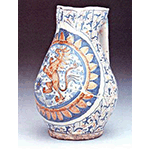
Definition and methods
According to the Italian Standards for Cultural Assets, UNI 10739 dated July 1998, the term ceramics refers to an "inorganic, non-metallic material, obtained from mineral raw materials, moulded cold and irreversibly consolidated by means of firing". Consisting mainly of clay, ceramics can have either a compact paste or a porous one. Classification of types of ceramics (terracotta, earthenware, majolica, porcelain, grès, etc.) is thus made on the basis of the different implementation of the various stages of the production cycle (modelling, drying, firing and, in some cases, enamelling and a second firing) and by the application of a possible finish (slip, enamel, transparent glaze).
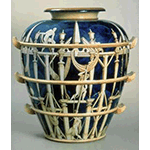
Two millenniums of ceramic art in Tuscany
The history of ceramics production in Tuscany boasts a long tradition. Among the most ancient testimony must be mentioned, for the Etruscan epoch, the tableware made of heavy bucchero, a production from the 4th-5th century B.C. typical of Chiusi, distinguished by thick walls decorated with sculptural motifs and with the classic dark grey-black colour obtained by firing the vases in a reducing atmosphere (poor in oxygen). For the Roman period we cannot, instead, forget the Aretine sigillata (commonly known as Aretine ware) that, in the 1st century B.C. and the 1st century A.D., became the most popular ceramic tableware of the whole empire.
The competition of foreign productions, such as the sigillata from southern Gaul and the one from Africa, brought an end to the production on an industrial scale of fine ceramic ware in Etruria and marked the emerging success of minor productions destined to a regional or sub-regional market. This situation lasted throughout the Early Middle Ages, in coincidence with a stage of profound economic and social transformation that involved the entire field of manufacturing activity.
For Tuscany, it was only during the Late Middle Ages and the Renaissance that workshops specialised in the production of enamelled ceramics of high quality began to emerge, located mainly in such "minor" centres as Montelupo and Asciano, gravitating in the orbit of the more important cities.
In the 17th and 18th centuries the production of ceramics experienced a second stage of transformation, linked mainly to changes in the technical and scientific knowledge of the period. While on the one hand this caused the interruption of some well-established activities, on the other it stimulated the introduction of new manufacturing processes on the part of local master ceramists coming from outside of the region who had moved to Tuscany. This was the origin, for instance, of the Chigi-Zondadari manufactories at San Quirico d'Orcia and the Ginori factories at Sesto Fiorentino. To these were added new factories in the 19th century, founded on the wave of industrial progress, such as the Chini Manufactory at Borgo San Lorenzo , the terracotta factories of Petroio and those of glazed ceramics at Anghiari. Some of these factories are still active today, while numerous ceramic objects conserved in national and foreign museums remain as testimony to the high quality and production levels reached by the other manufactories.
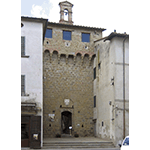
Arezzo and its territory
Among the provincial capitals Arezzo is perhaps the Tuscan city boasting the most ancient tradition in the production of fine ceramics. It was in this centre of Etruscan origin, in fact, that around the middle of the 1 st century B.C. there was created Aretine sigillata, a kind of fine ceramic tableware coral red in colour, whose name comes from the Latin term sigillum (plur. sigilla) which indicated the relief decorations applied by punching found on the finest examples. These objects, which in the more ordinary version had smooth walls, were marked in the earliest period by a stamp "in planta pedis" (so-called due to the typical shape of the border surrounding the inscription, resembling the sole of a foot) on which could appear the name of the shop or that of the ceramist. The conspicuous remains of this production, widely exported, are visible today in numerous national and international museums, outstanding among which, for Tuscany, is the Museo Archeologico Gaio Cilnio Mecenate in Arezzo .
Starting in the Middle Ages, Arezzo lost its role of leadership in the production of fine ceramics, a role taken over by minor centres such as Anghiari and Monte San Savino which, for the period ranging from the 14th through the 18th centuries, have left the greatest quantity of ceramic objects, among them important groups of decorated majolica. The production of Anghiari, in particular, was to evolve in the following centuries to the point of specialising, from the 18th to the 20th century, in the fabrication of glazed tableware with a characteristic glossy black colour.
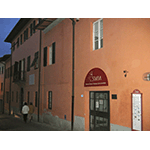
Pisa and the Valdarno
The privileged position of Pisa within the region had favoured, since antiquity, the development of economic activities. This is demonstrated by, among other things, the fact that, around 15 A.D., the Arezzo ceramists transferred the production of Roman sigillata to Pisa, where the vicinity of the sea offered greater commercial opportunities. In this city their activity continued until around 40 A.D., when it was supplanted by the arrival first of sigillata produced in southern Gaul and later by that of Africa. Thanks to close contacts with the Moorish-Spanish culture, products fabricated through the majolica technique, of ancient Middle Eastern origin, were widespread in Pisa notably in advance of other centres on the peninsula. These models inspired a production of local archaic majolica whose success, however, was to be suddenly interrupted in the years immediately following the Florentine conquest (1406). After a few decades, however, in the Pisa territory a new type of manufacture emerged, that of ceramics decorated with split graffiti, which was to predominate in the activity of the district up to and beyond the 18th century, taking its place alongside the fabrication of kitchenware in villages such as Vicopisano. Lastly, among the most recent manifestations may be mentioned the artistic terracottas of Dante Milani, an entrepreneur from the early 20th century active at Montopoli, who linked his fortune to a workshop specialised in the production of vases with a characteristic antique effect.
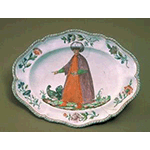
The Florentine area
It was certainly the presence of a major economic and administrative centre such as Florence to favour, since the Middle Ages, the development in the areas around it of renowned manufacturing localities such as those of Montelupo and Impruneta.
Famous for its refined majolica, Montelupo reached its productive peak between the middle of the 15th century and the 1630s, a period in which its ceramics not only satisfied the needs of prominent middle-class and noble Florentine families and great local institutions such as hospitals, monasteries and pharmacies, but were exported throughout the Mediterranean Basin. After a period of recession that lasted for almost three centuries, near the end of the 19th century Montelupo was able to resume its production of majolica, becoming, already in the early 20th century, one of the centres of greatest importance in the national panorama of ceramics manufacturers. Of its various stages of development, ample and precise documentation exists in the local Museo Archeologico e della Ceramica. Numerous are, moreover, the objects produced at Montelupo still in the possession of the ancient institutions to which they were originally destined, such as for example, the Spezieria di Santa Fina in San Gimignano .
Although smaller in size, another famous majolica factory was, at the end of the 15h century and throughout the 16th, the manufactory of Cafaggiolo, which supplied the grand-ducal family and some of the great Florentine institutions with tableware.
Inferior neither for the antiquity nor the quality of the objects produced is Impruneta, which owes its fame to its terracotta productions, in particular to the prized coatings and glazes that, from the 15th century on, embellished some of the most important Florentine monuments (exemplary is the case of the dome over Santa Maria del Fiore). Specialised also in jars for storage and in the production of ornamental terracottas, the centre continues to offer products of high quality, as demonstrated by the numerous kilns still operating in its territory .
Among the activities more recently established, special mention is due the Manifattura Ginori, which since the start of its production, in the first half of the 18th century, distinguished itself on the international level for the quality of its porcelain (attained through technological procedures that were innovative for the Europe of the time) and the refinement of the decorative repertories that still today distinguish the sophisticated design of its products.
Nor should we forget, in the late 19th century and the first half of the 20th, the brief but exciting "adventure" of the Manifattura Chini at Borgo San Lorenzo which, in addition to creating high-quality tableware, dedicated itself to the embellishment of the thermal centres of Salsomaggiore and Castrocaro.
-
 Archivio della Ceramica Sestese [The Sesto Ceramics Archive]
Archivio della Ceramica Sestese [The Sesto Ceramics Archive] -
 Museo Archeologico e della Ceramica di Montelupo [Montelupo Museum of Archaeology and Ceramics]
Museo Archeologico e della Ceramica di Montelupo [Montelupo Museum of Archaeology and Ceramics] -
 Museo della Manifattura Chini ['Manifattura Chini' Museum]
Museo della Manifattura Chini ['Manifattura Chini' Museum] -
 Museo Richard-Ginori della Manifattura di Doccia [Richard-Ginori Museum of the Doccia Factory]
Museo Richard-Ginori della Manifattura di Doccia [Richard-Ginori Museum of the Doccia Factory] -
 Spezieria di Santa Fina [Santa Fina Pharmacy]
Spezieria di Santa Fina [Santa Fina Pharmacy] -
 The kilns of Impruneta
The kilns of Impruneta -
 Museo Galileo - Section of Room XI. Science in the salon
Museo Galileo - Section of Room XI. Science in the salon
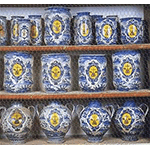
Siena and the minor centres in its territory
Like the Province of Florence, the Sienese territory boasts a long and important tradition in the history of majolica, distinguishing itself from the coeval Florentine production for a greater richness of the decorative repertory and, starting from the middle of the 15th century, for the characteristic decoration of the biscuit with slip (a technique consisting of covering with liquid clay the product that has been subjected to a first firing) applied prior to the enamelling process.
Recent studies have shown how, in addition to Siena, among the most important production centres in the Renaissance should be numbered Asciano, San Gimignano and in all probability Montepulciano, since most of the ceramic pieces found here date from the 17th century, a period considered to be one of general regression for the entire peninsula. It was at this time that the factories of Asciano, after the brilliant season of the Renaissance distinguished by the production of archaic majolica and ceramics decorated with slip and graffiti under glaze, entered a process of involution that was to lead, at the end of the 19th century, to the definitive abandonment of this activity.
If the new-found technological processes such as porcelain (invented in China in the 7th and 8th centuries A.D. but known in Europe only starting from the early 18th century) and earthenware caused the decadence of the ancient production centres, this renewed season of experimentation led to the founding of new manufactories all over Tuscany: for the Sienese territory the most famous of these is undoubtedly the Manifattura Chigi Zondadari at San Quirico d'Orcia, with its rich ceramic productions; of that destined to pharmaceutical institutions in particular, there remains a fine collection at the Abbey of Monte Oliveto Maggiore .
Lastly, we must mention the production of crockery for everyday use by the factories of Petroio, specialised from the late 18th century to the present in terracottas of large size produced, from the middle of the 19th century on, with the aid of plaster moulds .
****************************
Texts by Elena Fani
English translation by Catherine Frost
Last update 10/gen/2008


